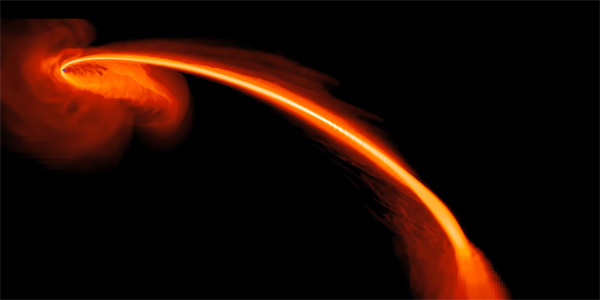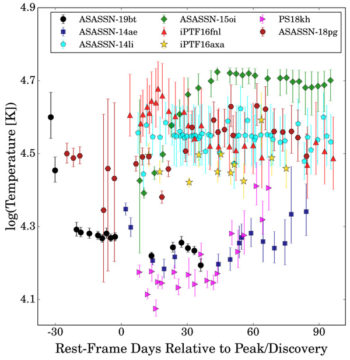NASA's TESS exoplanet-hunting satellite has provided astronomers with a front-row seat as a black hole shreds a close-venturing star.
What happens when a supermassive black hole shreds a star?
One such tidal disruption event (TDE) is showing astronomers that there’s still a lot we don’t know about these rare, distant, and brilliant phenomena.

NASA/S. Gezari (JHU) / J. Guillochon (UCSC)
Disruption Discovery
It’s pretty rare that a black hole tears into a close-venturing star — a Milky Way-type galaxy might see a supernova every century, but only see a TDE every 10,000 or 100,000 years. Now, though, automated telescopes scanning the night sky are catching more and more star-shredding events as they happen throughout the universe.
Case in point: ASASSN-19bt. This event is named for the All-Sky Automated Survey for Supernovae (ASASSN), a robotic network of 14-cm telescopes at multiple sites around the globe. On January 29, 2019, the network’s South African unit spotted a galaxy whose nucleus had suddenly brightened.
The network automatically issued an alert that went to Thomas Holoien (Carnegie Observatories), who was working at the Las Campanas Observatory in Chile at the time. Holoien slewed two Las Campanas telescopes to ASASSN-19bt, then requested follow-up observations from NASA’s Neil Gehrels Swift Observatory, the European Space Agency’s XMM-Newton, as well as 1-meter ground-based telescopes that are part of the Las Cumbres Observatory network, set up around the globe to watch such transient events around the clock.
But another telescope was watching too: the Transiting Exoplanet Survey Satellite (TESS), recently launched to hunt for transiting exoplanets. Because this event happened in a region of the sky monitored almost continuously since December 2018 by TESS, Holoien and his colleagues were able to watch most of the event, starting only days after it began. They've published the observations in the September 27th Astrophysical Journal (full preprint available here).
An Ordinary Event?
In many respects, observations of ASASSN-19bt show something similar to every TDE that astronomers have seen. The star gradually brightens as it tears apart under the black hole’s gravitational forces. Spaghettified into a long stream, the stellar remains take two paths — half escapes while the other half swings around the black hole, eventually losing energy and falling in. Gradually, the debris (and the bright light we see in the visual, ultraviolet, and X-ray wavelengths) fades from view.
Suvi Gezari (University of Maryland), who was not involved in the study, praised the precision of the TESS light curve, which represents the event’s changing brightness over time.
“Now,” she adds, “the hard part is understanding what is driving the shape of the light curve.” Is the light we’re seeing coming directly from the star’s remains as they rain neatly into the black hole? Or is the light diffusing through a messy stream of debris?
Explaining the Unexpected

T. Holoien et al. / Astrophysical Journal, Sept. 27, 2019
Astronomers have typically caught star-shredding events at their brightest. But with TESS and other early follow-up observations, astronomers collected more early data on ASASSN-19bt than any other TDE yet observed. In the process, they uncovered another mystery.
Just after observations began, ultraviolet data collected by the Swift satellite determined that the source’s temperature, as well as its UV luminosity, were dropping precipitously, from 40,000 to 20,000 Kelvin (71,500 to 35,500ºF) in just a matter of days.
“[The event] must have had a previous maximum that we didn't observe, which we see it declining from,” Holoien explains. “We just don't know exactly how bright it was, or exactly when that first peak occurred.”
If there really was an early peak in temperature and brightness, it’s “pretty unexpected,” Holoien adds. That’s in large part because no other TDE has ever been observed so well from the beginning of the event — astronomers have had only sparse data on what happens from the first moments that a star begins to come apart in a black hole’s gravitational field.
Gezari cautions that the data around the beginning of the Swift observations are noisy, and the early peak hinted at in the Swift data isn’t present in the TESS data. Nevertheless, the hint of an initial spike is intriguing, she says, “and definitely argues for more, prompt ultraviolet imaging of young TDEs to see if this phenomenon is a signature of the earliest phases of a TDE.”
That’s going to change, and soon. With automated observatories scanning the skies from ground and space, and more coming online soon, it won’t be long before we capture the entirety of a star-shredding event.
 0
0
Comments
You must be logged in to post a comment.